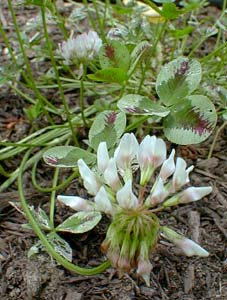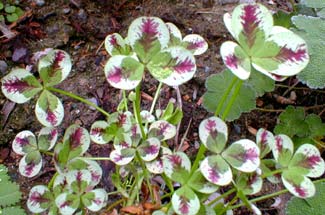
Dragon's Blood Clover
I but seem to see the fluent plain
Rise toward a rain of clover-blooms, as lakes
Pout gentle mounds of plashment up to meet
Big shower-drops.Ý Now the little winds, as bees,
Bowing the blooms come wandering where I lie
Mixt soul & body with the clover-tufts,
-Sidney Lanier
(1842-1881)
(1842-1881)
I'd never seen this odd little clover before, when for the first time I spotted a most pitifully scruffy little pot of it in a favorite garden store. Despite its poor condition, it was easy enough to see that as clovers go, this one was wildly unique with a fantastically patterned tricolor leaf of cranberry-red, creamy white, & pale green.
Although clover cultivars such as Trifolium repens 'Dragon's Blood' are not the vastly spreading things that wild purple clovers or white clovers are, they are nevertheless very easy to grow, so I didn't think it was going to be a waste of money to buy that poor little dried out pot. I brought it home, planted it in a moist spot under the Catawba Album rhododendron, & it perked right up immediately, fast on its way to becoming a respectable creeping groundcover.
 Fancy as are the leaves, its flower is "just" a plain but pretty white clover flower, a half-inch pompom, blooming at least May & June, with later summer reblooms possible. The flower close-up above was snapped in June, a month after the leaf portrait at right.
Fancy as are the leaves, its flower is "just" a plain but pretty white clover flower, a half-inch pompom, blooming at least May & June, with later summer reblooms possible. The flower close-up above was snapped in June, a month after the leaf portrait at right.In our garden it has proven to be fully evergreen. If it periodically loses some of the sharpness of the unusual coloration, it can be cut back dramatically to near the center of its wide spread, & it will pop right back out most colorfully. It's suited for zones three through nine, & does well in poor or rich soil either one.
As an aside, I can't resist mentioning how this clover was marketed. Nowhere on the label did it mention that it was clover. It was labeled "Dragon's Blood Trifolium," & the description on the tag went so far as to say it had "clover-like flowers."
It was obvious the grower or at least the grower's label-writer was worried that the invasiveness of wild clovers would keep some gardeners from being tempted by an ornamental clover. So they slyly said it was "clover like" instead of admitting forthrightly it's clover.
But the nursery completely undermined the grower's misleading intent by placing the clover alongside a couple varieties of oxalys. Thus if anyone didn't know Trifolium was a clover, they would've assumed by its associates that it was some kind of oxalys, which also has invasive wild species that cause unknowing gardeners to fear even the good ones!